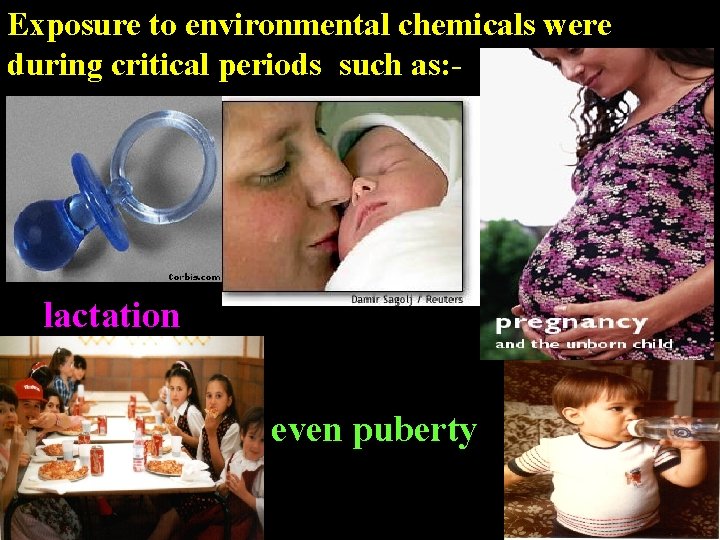Presented by Mokhtar Ibrahim Yousef Prof of Environmental


Presented by Mokhtar Ibrahim Yousef Prof. of Environmental Animal Physiology Vice Dean for Postgraduate Studies and Research Faculty of Specific Education Alexandria University

Plastic

Plastic products can likely be found in every room in the house: food containers, plastic wrap, drinking bottles, toys, shower curtains, shampoo bottles, water pipes and many other products.

Plastic is: 1 - Convenient, 2 - Lightweight, 3 - Unbreakable 4 - Relatively inexpensive. However, there are both environmental and health risks from the widespread use of plastics.


Plastic Consumption

Annual US Plastic Resin Production & Recovery

Western Europe Plasticiser Consumption (‘ 000 s of tons) Source: ECPI, 2006

Egypt Population & Waste Generation Egypt population > 78 million Waste generation 16. 2 million MT/Y Plastic amount 972, 000 MT/Y Plastic Development Center-Alexandria ptc_ei@mfti. gov. eg April 2007.

Egypt Waste Composition Social standard of living affect waste composition High income areas produce more paper, metal, plastics Low income areas produce more organic food waste Source : EEAA & METAP Waste type Organic waste Papers and carton Plastic Glass Metals Textile Others Percentage 50 -60 10 -25 3 -12 1 -5 1. 5 -7 1. 2 -7 11 -30




Plastic Development Center-Alexandria ptc_ei@mfti. gov. eg April 2007. Egypt

Plastic Development Center-Alexandria ptc_ei@mfti. gov. eg April 2007. Egypt

Plastic Development Center-Alexandria ptc_ei@mfti. gov. eg April 2007. Egypt


Not all containers are labeled and a recycling symbol on a product doesn’t mean it’s recyclable.

Commonly, only #1 and #2 with narrow necks are recyclable, but some communities recycle other plastics with narrow necks (#3). ﺧﻄﺮ ﺍﻟﻨﻮﻉ ﻭﻫﺬﺍ ﻋﻠﻰ ﻻﺣﺘﻮﺍﺋﺔ







PVC Polyvinyl chloride

PVC is increasing Globally

PVC plastic has problems: An ‘Environmental Poison’ and why some governments and industry are phasing it out. Clean Production Action www. cleanproduction. org (launched by end of March) March 7, 2003

• Myriad problems of PVC: 1 - It is made of chlorine. 2 - It requires large amounts of additives to be functional.

• Pure PVC consists of 57% chlorine. • All precursors (Ethylene. Dichloride, EDC; Vinylchloride Monomer, VCM) are highly toxic.

Million tonnes • PVC biggest source of chlorine in municipal waste stream – arguably most important source of dioxins to environment today.

• Incineration leads to equal or more waste generation: • 1 kg PVC = more than 1 kg hazardous residues.

• Combustion leads to HCl and Dioxins.

Chlorine in = Dioxin out • Danish gov’t now trying to limit PVC in incineration waste streams • “review of data clearly shows correlation with chlorine input and synthesis of dioxins and furans” USEPA 2000 2020 Bags of incineration ash from PVC combusion



Dioxin poisoning Viktor Yushchenko - 3 rd President of Ukraine Endured Dioxin poisoning, likely by his political foes, which along with nearly killing him, left his skin severely disfigured.



Common plastics additives • • • Antimicrobials Antioxidants • Antistatic agents Blowing agents • Catalysts/curing agents • Colorants • Fillers • Free-radical initiators • Impact Modifiers Lubricants/mold releasers Reinforcers Heat stabilizers Ultraviolet stabilizers Plasticizers Flame retardants Since they’re just “mixed in” they can migrate out! (www. Mindfully. org; Stringer et al, 2001)

PVC legacy about to hit • 300 million tons PVC produced globally since 1960 s. • Half already disposed to landfills and incinerators. • Half still in current use (construction materials = average life 34 years). • So what do we do with it?

What the PVC industry says…

Plastics additives Danger may lurk in the most unexpected places.

Plasticizers Danger may lurk in the most unexpected places.

Plasticizers ﺍﻟﻠﺪﺍﺋﻦ • Often volatile molecules that are added to hard, stiff plastics to make them softer and more flexible. • From http: //www. epa. gov/envirohealth/children/background/glossary. htm

Phthalates as Plasticizers

What are Phthalates? • Phthalates are a class of widely used industrial compounds used as plasticizers especially in PVC (polyvinyl chloride) • Various types of phthalates –Range from one carbon to seventeen carbons –PVC plasticizers generally range from 4 -13 carbons

Annual production of phthalates in EU: 3. 5 million tons/year 1 • Di-(2 -ethylhexyl)-phthalate (DEHP): 2. 1 million 1 tons/year DEHP: the most common phthalate ester l l Imparts flexibility to PVC based plastics 1 Lorz DEHP et al. , 2002. Ullmann‘s Encyclopedia of Industrial Chemistry

Phthalates – plastic softeners Found in:

Apply Make-up Hair spray, deodorant, nail polish, make-up, perfumes… • Absorbed through the skin, inhaled, ingested. • Animal studies: damage to liver, kidneys, lungs and reproductive system – especially developing testes. (Environmental Health Perspectives 2005).

Apply Make-up Human studies: Direct correlation between levels in pregnant women and subtle genital birth defects in their year old sons. (Environmental Health Perspectives 2005).

Other Uses • Shampoos • Bath soaps • Detergents • Aftershave lotions




Phthalates in Floor • Flooring manufacturers combine phthalates with PVC powder to make a soft and flexible finished product. • Manufacturers use several different types of phthalate; DINP, DEHP, BBP and DIHP are all used for floors.

Phthalates in Floor • Phthalates can migrate out of PVC flooring (for example, during and after cleaning).

Automotive Use • Today’s average car contains more than 1, 000 plastic parts. • Approximately 12 per cent of all of these by weight are made of soft PVC, principally as underbody coatings and sealants, wire harnesses, passenger compartment parts and small exterior trims and fittings.

Automotive Use • New car smell: Partly the pungent odor of phthalates volatilizing from a hot plastic dashboard. • In the evening's cool they then condense out of the inside air of the car to form an oily coating on the inside of the windshield.


Uses of Phthalates Medical devices: • • Intravenous (IV) bags and tubing Umbilical artery catheters Blood bags and infusion tubing Enteral nutrition feeding bags Nasogastric tubes Peritoneal dialysis bags and tubing Tubing used in cardiopulmonary bypass (CPB) procedures • Tubing used in extracorporeal membrane Oxygenation (ECMO) • Tubing used during hemodialysis.

Other Uses • Coatings on numerous pharmaceutical products

Uses of Phthalates Medical devices: Why is there concern over DEHP in medical devices? • It has been shown that DEHP can leach from PVC devices into fatty solutions like blood or nutrition formulas. • At certain doses, DEHP has been shown to cause reproductive birth defects and infertility in animals.

Leaching from Medical devices • Estimates of exposure levels indicate that dialysis patients may receive doses as high as 40 mg/day.

Leaching in Foods • Phthalates migrate into food from plastic food wraps. • A recent survey of U. S. cheeses found that phthalates directly migrate from commercial PVC and PVDC plastic wrapping into Fatty items like cheese and meat.

Leaching in Foods Leaching increases when plastic comes in contact with oily or fatty foods, during heating and from old or scratched plastic.

Leaching in Foods • In the cheeses: ". . . very heavy migration (50 to 160 parts per million) of the DEHA into cheeses in deli cling wrap.

Leaching in Foods • People who ate several ounces of this cheese every day could get doses nearly as high as those linked to a host of health problems in lab animals.

Leaching in Foods • Studies have found that phthalate levels in foods like crisps, chocolate bars and cheeses are in the tens of mg per kg range. The highest level found in dairy products was 114 mg/kg in soft cheese (ENDS, 1995).

Leaching in Foods • These analyses led to a prediction that the daily intake of phthalates by an adult averaged 0. 8 mg/person/day (0. 013 mg/kg body weight/day), up to 1. 6 mg/person/day (0. 027 mg/kg body weight/day) for someone with a diet high in phthalate-containing products.



Phthalates-Free Plastic • In 2002, Germany launched Hexamoll DINCH which is a nonphthalate plasticiser developed specifically for use in sensitive PVC applications, such as toys, medical devices and food contact applications.

Phthalates-Free Plastic • Hexamoll® DINCH was subject to a large number of toxicological tests (All tests confirmed that there is no excellent toxicological). • Hexamoll® DINCH is also remarkable for its extremely low migration rate.

What you can do Avoid certain types of plastics for food. Plastics used for food storage usually have a number code on the bottom, which will tell you what type of plastic it is.

What you can do According to the Green Guide, it is best to avoid: Plastic #3: Polyvinyl chloride (also known as PVC or vinyl), which is found in a wide range of products, including some plastic wraps and food containers.

What you can do According to The Green Guide, it is best to avoid: Plastic #6: Styrene, which is found in Styrofoam products, such as take out containers, Styrofoam cups and egg cartons.

What you can do According to The Green Guide, it is best to avoid: Plastic #7: Polycarbonate, which is found in some sport water bottles, some baby bottles, toddler drinking cups, and 5 gallon water bottles.

What you can do Avoid heating food in plastic containers or with plastic wrap (some plastic wraps are made with PVC). Use a paper towel or a glass or ceramic lid to cover food in the microwave. Store food in containers made of glass, ceramic or food-safe metal.

Leaching in Water Phthalates are also commonly found in groundwater, rivers and drinking water. Researchers in Holland have found up to 3. 5 micro-g/l of DEHP in drinking water (ENDS, 1999).

In Water • Concentrations range from 0. 01 µg/litre (in 6 of 10 US cities) to 1. 0 µg/litre (in Miami, Florida) found in drinking-water samples.

Which plastic water bottles don’t leach chemicals? Check the recycling symbol on your bottle. If it is a #2 HDPE (high density polyethylene), or a #4 LDPE (low density polyethylene), or a #5 PP (polypropylene), your bottle is fine.

Which plastic water bottles don’t leach chemicals? The type of plastic bottle in which water is usually sold is usually a #1, and is only recommended for one time use. Do not refill it.


Air Diethyl phthalate has been measured in the indoor air of a telephone switching office and in outdoor air in Newark, USA, at concentrations ranging from 1. 60 3 to 2. 03 µg/m and from 0. 40 to 3 0. 52 µg/m , respectively, during a 43 -day sampling period.

Plastics Exposure in Childhood: Is there Evidence of Exposure?

Uses of Phthalates Child’s toys

The toy industry, a global business • Total toy market, excluding video is US$ 55 bn of which: • US US$ 24 bn – number of children 67 M • EU US$ 12 bn – number of children 126 M • Which means that there a lot of toys around the home.











Health Risks of plastic: - PVC – Phthalates - Styrene -Polycarbonate (Bisphenol A; BPA)

1 - PVC-Phthalates (DEHA)

DEHA Exposure DEHA exposure is linked to negative effects on: 1 - The liver, kidney, spleen, bone formation and body weight. 2 - It is also a possible human carcinogen (3). 3. U. S. EPA, Integrated http: //www. epa. gov/iris/subst/0356. htm Risk Information System.

2 - Styrene

Styrene Exposure Styrene is toxic to the brain and nervous system, among workers with longer-term exposures (4) but also has been found to adversely affect red blood cells, liver, kidneys and stomach in animal studies (5). 4. Benignus VA, geller AM, Boyes WK et al, 2005. “Human neurobehavioral effects of long-term exposure to styrene: a metaanalysis. ” Environ Health Perspectives, 113(5): 532 -538. 5. U. S. EPA, Styrene Fact Sheet, Dec. 1994, available at http: //www. epa. gov/opptintr/chemfact/styre-sd. txt

Styrene The FDA has determined that the styrene concentration in bottled drinking water should not exceed 0. 1 ppm. The Occupational Health and Safety Administration (OSHA) has limited workers’ exposure to an average of 100 ppm for an 8 -hour workday, 40 -hour workweek.

3 - Bisphenol A (BPA)

Bisphenol A (BPA) BPA is polymerized into polycarbonate plastic (#7, e. g. Melamine).

Bisphenol A (BPA) Unfortunately, most plastic baby bottles and drinking cups are made with plastics containing Bisphenol A. In 2006 Europe Banned all products made for children under age 3 containing BPA.

Bisphenol A (BPA) BPA is released 15 to 55 times more rapidly than before exposure of baby bottles to hot water (8 to 32 nanograms per hour).



















Exposure to environmental chemicals were during critical periods such as: - lactation even puberty

Thank you for your kind attention 25/07/42 ﺗﻮﻓﻴﻖ ﺑﻦ ﺃﺤﻤﺪ ﺧﻮﺟﺔ. ﺩ 129
- Slides: 129